Chapter 15 - Religion
Religion is a unified system of beliefs, rituals, and practices that typically involve a broader community of believers who share common definitions of the sacred and the profane. Sacred is the supernatural, divine, awe inspiring, and spiritually significant aspects of our existence. Profane is that which is part of the regular everyday life experience. The definitions originated from Durkheim's studies of religion (see 1947 The Elementary Forms of Religious Life, Glencoe Press reprint of 1912). For you, religion might be a personal definition of how you feel about your place in the universe. It may also reflect how you understand categories of people who share a common system of beliefs that differ from your own (Jews, Muslims, Christians, etc.).
For sociologists, religion is typically studied in two typical approaches: first, a cultural approach that evaluates the religious aspects of the culture shared by followers of a certain religion; second, a theoretical approach to religion including its symbols, functions, exchange-based interactions, and power issues. Religion has always been an important issue at both levels of society: personal and larger social.I want to mention that for many who are faithful and actively participate in their religion, studying it as we will in this chapter may be a bit off-setting. Just as we approached culture with “Cultural Relativism= the tendency to look for the cultural context in which differences in cultures occur. Cultural relativists like, respect, observe, and even study other cultures (including their religions) without trying to change the views of those within the religion. To extend the “ice-cream” metaphor used back in Chapter 5, we are not trying to turn Vanilla Ice Cream into Chocolate Icecream by studying it. We are simply studying it. I invite you to take the Sociological view with me in this Chapter on religion. Keep and protect your personal values and beliefs and study religion to more clearly understand and observe it’s influence on individuals (Personal Level) and on: communities, states, countries and even the entire world (Larger Social Level).
As mentioned in Chapter 5, there are many religions located in the 267 Countries. In Table 1 you can see that collectively Christians make up about one-third of the world populations. The CIA also estimated the 2015 world population to be at 7,684,292,383 (As of July, 2020). The CIA data also gives an estimate in 2020 of percent of the World’s 2015 Population that belongs to the categories of religious denominations. A Religious Denomination=is a subgroup within a religion that functions under a common name and consider themselves to be distinct from other denominations and religions. By placing the 2015 religious percentages to the year 2020 population we can provide a fairly close estimate of the actual numbers of people in each religion as of 2020.
Table 1: Religions of the World 2015 (with Estimated Population numbers for 2020)*
- Christian 31.2%. (Est.2.4 billion)
- Muslim 24.1% (Est.1.9 billion)
- Hindu 15.1%. (Est.1.1 billion)
- Buddhist 6.9%. (Est.530 million)
- folk religions 5.7% (Est.438 million)
- Jewish 0.2%. (Est.15.4 million)
- other 0.8%. (Est.61.5 million)
- unaffiliated 16%. (Est.1.2 billion)
The United State's Religions
In 2012 the Association of Statisticians of American Religious Bodies produced its 2010 US Religion Census: "Religious Congregations & Membership Study" (see SOURCE ).This study’s findings reported that 150,686,156 people belong to a formal religion in the US with 344,894 congregations in which they belong. They reported that: about 50 million belonged to evangelical and conservative protestant groups; nearly 23 million belonged to mainline protestant groups; about 60 million belonged to the Roman Catholic church; nearly 5 million belonged to Black Protestant groups; 6 million belonged to The Church of Jesus Christ of Latter-day Saints (historically called “Mormons”); and nearly 8 million belonged to other groups. The 2020 Religious Census (not the same as the U.S. Census, 2020) is currently being conducted by the same organization and will have results available sometime in 2022. Until then we will have to use other data sources that provide estimates based on samples and a variety of research techniques.
In 2016, the Gallup Polling organization reported that there were 21 percent of U.S. adults without a religious identity and that in 2008 that was only at 15 percent; and back in 1950 only 5 percent had no religion. The report also indicated that 74 percent were members of sa Christian religion and 5 percent belonged to a non-Christian “Other” religion. Gallup found that in their ongoing surveys, the percentage of those not belonging to any religion began to increase in the 1970s and reached 10 percent in 1990. Newport stated: “The most significant trend in Americans' religiosity in recent decades has been the growing shift away from formal or official religion.” (see Newport, F. (23 Dec. 2016). “Five Key Findings on Religion in the U.S.” retrieved 17 July 2020 from SOURCE). Figure 1 shows a list of 5 U.S. Denominations found in the surveys they conducted 2010-2019. Larger social trends, specific to religions are shown here. Between 2010-2019 the following denominations saw increases: Catholics (1%); Christians (those Christians not belonging to others listed, 2%); and Other (2%). Between 2010-2019 Protestants (10%) and Mormon (1%) saw decreases. Jewish remained unchanged (2%). And the trend Newport identified above shows that those not connected to any religion “None” rose 7 percent (2010 at 14% up to 2019 at 21%). On the same Gallup URL they report how survey respondents responded to the question “How important would you say religion is in your own life?” Between 2010-2019 there have been trends that coincide with the data above. For example, those saying “Very Important” declined by 10 percent (59% down to 49%); those saying “Fairly Important” declined 3 percent (29% down to 26%); and those saying “Not Very Important” rose 5 percent (20% up to 25%; see Gallup “Topics A-Z: Religion” retrieved 17 July 2020 from SOURCE ).
Figure 1. Gallup* Ten Annual Surveys: Belonging to 5 U.S. Denominations 2010-2019.
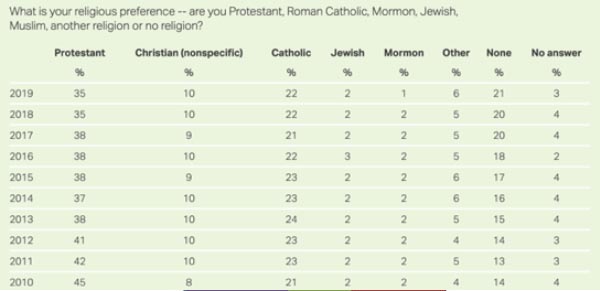
Finally, in support of answering some questions you may already have; let’s look at Gallup’s ongoing measure US religiosity data during 2010-2019. Religiosity= is the measurable importance of religion to a person's life. Religiosity can be measured by considering: how active someone feels in their religion; how often someone attends formal services; how much money they donate; how often they privately worship in their home; and other factors. When asked each year between 2010 and 2019 “Did you, yourself, happen to attend church or synagogue in the last 7 days or not?” there was an overall 5 percent decline in those saying “Yes” (in 2010 was at 39% said “Yes” and in 2019 only 34% said “Yes”).
We can conclude that the larger social trend is an overall decline of religious participation, attendance (at least attending in last 7 days); and in other values (see other time series data at SOURCE ). This is very important in U.S. society for the current and future state of society. Why? Because participating and not participating in formal religion impacts individuals and their groups who impact communities and states and eventually the entire nation. Let me give a few examples of how.
As mentioned in previous chapters we have established some generations in U.S. Society and know that they are not exactly identical to the generation that preceded them in their values and behaviors. For example, Bab Boomers (1946-1964) had much higher divorce rates than previous generations. Gen X . (1965-1978) are the children of the Baby Boomers and liked their own parents much less than previous generations like their parents. The Gen Y or Millennials (1980-2000) children had exceptionally positive and close connections with their parents. Generation Y are also called the "Internet Generation" or "Screenagers" because they grew up with TV, video games, cell phones, PDAs, and movie screens (see Youtube video narrated by a PEW researcher named Paul Taylor ). The newest generation that followed Gen Y Millennials is now called Generation Z (1996- and still growing) also have great relationships with their parents but are the “Smart Phone” generation. Many recent studies show similarities in Generations Y and Z on many issues.
In 2019 a survey was collected of 2,000 U.S. Generation Z individuals in which their religious affiliation was assessed. Generation Z was reported to reflect a leveling off of the unaffiliation trend toward religion. Generation Z and Generation Y had 38 percent who selected Unaffiliated. This study also reported that 45 percent of Generation Z attended church “Rarely or Never” with about 50 percent of White, 29 percent of African Am./Black, and 44 Percent of Hispanic/Latin “Rarely or Never” attending (see Deckman, M. (10 Feb., 2020) “Generation Z and Religion: What new data show” retrieved 17 July 2020 from SOURCE).
From a 2020 PewResearch report we gain some insight into just how religion and other values differ between generations. Generation Z has been found to have many similarities to Generation Y, but also some very unique characteristics. For example, Generation Z is more ethnically and racially diverse (Baby Boomers are 82% White; Gen X are 70% White; Gen Y are 61% white and Gen Z is only 52% White). Gen Z will likely be more educated that previous generations (Baby Boomers-15% Have Bach. Degree; Gen X-24% Have Bach. Degree; Gen Y-33% Have Bach. Degree; and Gen Z-44% Have Bach. Degree). Generation Z also has higher levels of its members supporting: Climate Change being “human caused; want a more “activist government”; and the belief that blacks are being treated less fairly (43% Republican and 82% Democrat Gen Z’s).
Religions tend to teach and reinforce conservative values in the minds and hearts of its members. With the highest Generational levels of being religiously unaffiliated, Generations Z and Y would be expected to interact less conservatively than previous generations toward conservative intuitions. For example, those with religious affiliation who participate more tend to support marriage between a man and a woman; marriage being acceptable and cohabiting less acceptable; and plans to marry themselves. Another PewResearch study reported that Generation Z reported same-sex marriage as “being a good thing” more than other generations (48% Gen Z, 47% Gen Y, 33% Gen X, and only 27% Baby Boomers). Generations Z and Y reported the highest levels of cohabitation before marriage and single women raising children on their own as being a “Good thing” (see PewResearch, Parker, K. & Igielnik, (14 May, 2020) “On the Cusp of Adulthood and Facing an Uncertain Future: What We Know About Gen Z So Far.” R. retrieved 2 July 2020 from SOURCE ).
Another 2016 PewResearch report indicated that in 2014, Generation Y was the generation with the highest proportion of members ages 18 to 34 who stilledwith their parents in United States’ history (see Fry, Richard. 2016. “For First Time in Modern Era, Living With Parents Edges Out Other Living Arrangements for 18- to 34-Year-Olds.” Washington, D.C.: Pew Research Center, May retrieved 17 July 2020 from SOURCE). With Generations Y and Z having many traits and characteristics in common, I search for any report on their living arrangments as of 2020. Since they are still very young and not reached the age at which marriage or cohabitation might be a choice, no reports were to be found. I did download the age specific living arrangments of U.S. adults in a variety of age groups, combined their data for 2019 and created barcharts of their marital status as reported by the U.S. Census in 2019. Figure 2 shows these charts. In many measures comparing the similarities between Generations Y and Z, they do have very similar marital statuses and living arrangments in 2019. Generation Z is in the 18-24 categories for Men and Women. Like the Generation Z found to still be living at home with their parents, Generation Z Men (56.0%) and Women (52.0%), at least by ages 18-24 still lived with their parents as the most common arrangement. Look at Generation Z (ages 25-34) and you can see that the percentage of still living with their parents was only 19.0 percent for Men and 12.0 percent for Women; and the percent married and cohabitating was lower for Men (36.0% Mar. and 14.0% Cohab) and higher for Women (45.0% Mar. and 15.0% Cohab).
Figure 2. U.S. Census % Marital Status for Men and Women by Age Categories
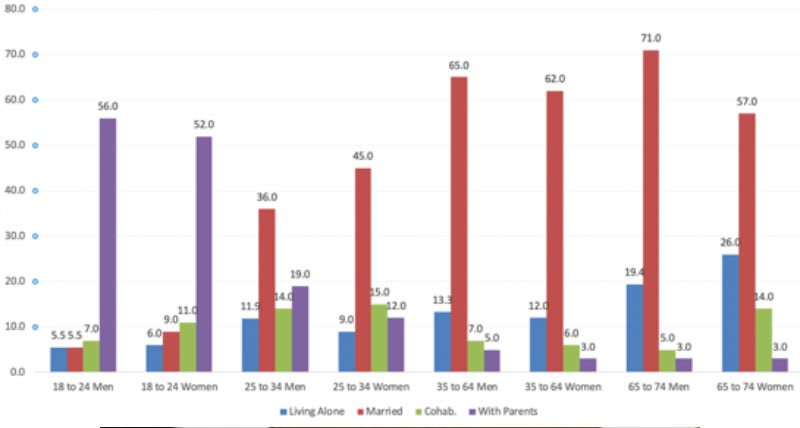
I’ll provide one final example of how religious participation and affiliation influence how individuals in society influence their larger social levels and society. In 2020, racial protest erupted again and many diverse people came out to peaceful protest the mistreatment of Blacks by law enforcement officers. PewResearch surveyed the U.S. population through their online American Panel Survey. They found many surprising factors relating to U.S. citizens reaction to and participation in the peaceful protests. Figure 3 Shows these results. Generation Z respondents (Ages 18-29) reported the highest levels comparing age groups of having conversations with family or friends (73%); the highest level of posting or sharing content on social media networking sites (53%); of contributing money to an organization (21%); of contacting a public official to express their opinion (13%); and of actually attending a protest (13%). Generation Y scored 2nd highest in evry one of these categories.
Figure 3. PewResearch 2020 Protests Survey Results
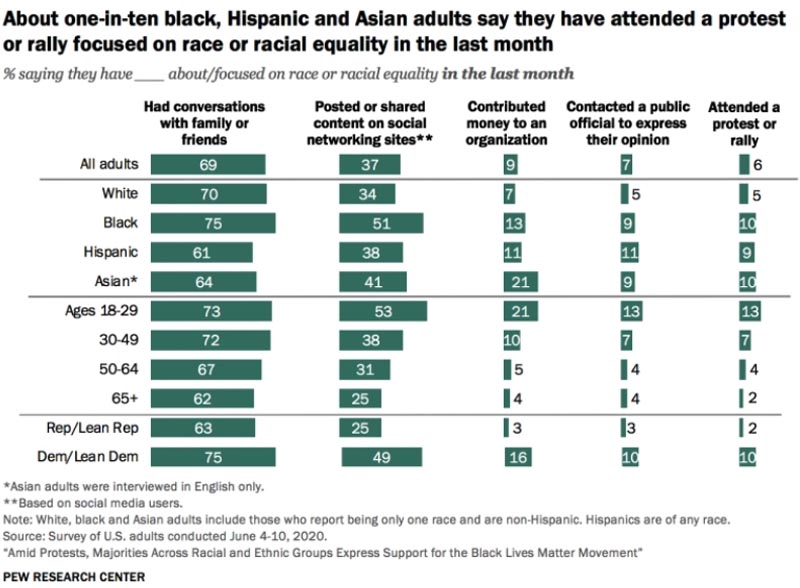
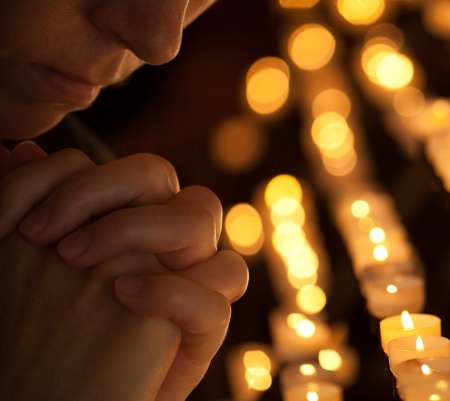
Figure 4. Photo of Book Oneness: Great Principles Shared by All Religions
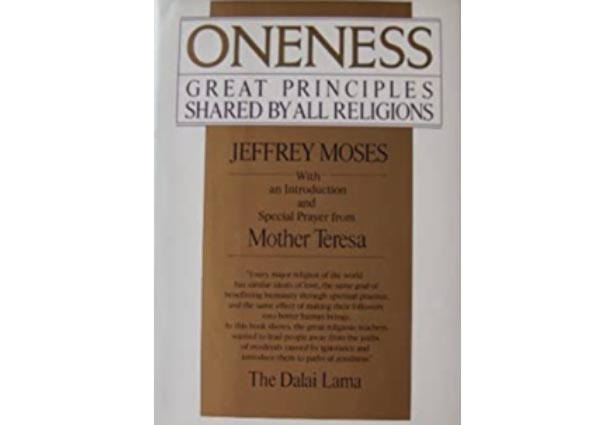
I mentioned that I wanted you to take the sociological perspective in studying religion, including the cultural relativist perspective. I still do and hope you still are. To take such an open-minded stance requires a concerted effort on our part. To be able to feel secure enough in our own beliefs to find acceptance in the beliefs others have takes devotion to our own faith and deep caring about the quality of the human experience in our many relationships. We mistakenly believe that we have strength in commonality when often there's just as much strength found in mutually-respected tolerance of different people who respect and honor one another.
Most people from most of the world and US religions share most beliefs in common. It's true, but we more often define ourselves based on differences not similarities. Most of us could peacefully live as next-door neighbors and peacefully co-exist. In fact, the more you talk to one another about your beliefs and the more you agree to accept one another and respect one another's free choice, the more understanding and tolerant you'll become. For example, there's a category of religions in the world called the Abrahamic Religions are those religions which trace their religious ancestry back through "Father" Abraham. Look at Figure 3 below:
Figure 5. Genealogy of Abrahamic Religions
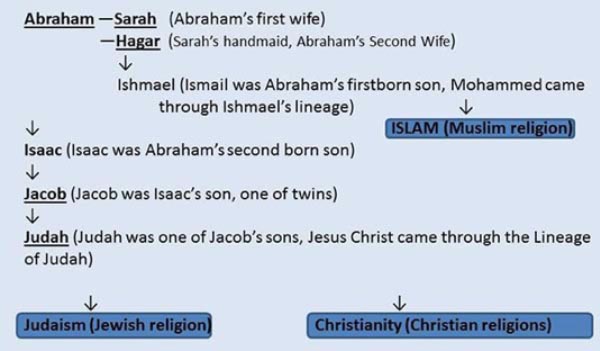
Abraham had a wife named Sarah who could not get pregnant. She gave Abraham her handmaid, named Hagar, as a second wife. Hagar had Abraham's firstborn son, Ishmael. Ishmael and Hagar ended up in the wilderness and were miraculously preserved from exposure, dehydration, and starvation. Eventually, Ishmael would father 12 princes as his sons. From one of his sons, Mohammed was born, and with him, Islam or the Muslim religion.
Abraham eventually fathered a child with Sarah resulting in the birth of Isaac. Isaac fathered Jacob and Jacob fathered sons, including Judah. From the lineage of Judah came the Jewish religion and eventually Jesus Christ was born a Jew and began Christianity in all its forms. All three Abrahamic Religions combined account for about 56 percent of the world’s current population. Father Abraham was promised by God that his descendants would eventually inherit a piece of land called Canaan which had about the same land mass as New Jersey and is called Israel in our day. Christians, Muslims, and Jews have battled and argued over this holy land for centuries and do to this day. I often tell my students that the prophecy stated that Abraham’s descendants would inherit the land, not get along together once they did.
Another major genealogical origin of world religions is called Indian Religions are those which originated from the Sub-Asian continent of India. Though the record of these religious origins is a bit more vague than found with the Abrahamic religions, Hinduism, Buddhism, Sikhism, and Jainism are major world religions which represent about 1,100,000,000 people today.
There are a classification of religions that sociologists use to distinguish them based on beliefs and rituals. Simple Supernaturalism has no gods, but focuses on human & non-human supernatural forces which influences us for better or worse. Animism also has no gods, but focuses on good or evil spirits which inhabit animals, rocks and/or people and animals (Simple supernaturalism and Animism underlie Japanese Animism plot structure and themes).
Theistic Religions have divine beings that are Gods. There are three Monotheistic Religions. Monotheistic Religions are religions that have one single all-powerful God: Islam, Judaism, and Christianity.
Polytheistic refers to religions with multiple Gods such as Hinduism. About 2/3rds of all people of the world worship in a theistic manner. Abstract Ideals refers to religions that focus on sacred principles and thoughts, which guide our lives and typically have no divine beings in charge of the world and universe. Buddhism is an example of an abstract ideal religion.
The Functions of Religion
Let's now talk a bit about the functional aspects of religion in the larger social picture. If you remember from our chapter on the Sociological Imagination, religion is one of the 7 social institutions in society (media, technology, government, family, economy, and education are the others). For decades sociologists have studied the functional aspects of religion as a social institution. It is safe to conclude that religions are functional (and sometimes dysfunctional) at both the personal and larger social level.
Table 2 below shows eight functional aspects of religion.
Functions of Religion
- Religion answers the deepest questions of existence
- Religion provides emotional comfort
- Religion facilitates social solidarity
- Religion provides guidelines for everyday life
- Religion facilitates social control
- Religion provides for continuity and adaptation
- Religion provides support for governments
- Religion are often part of social change
Let me share a personal experience with you that will illustrate these functions of religion at my own personal level. In 1986 I worked during the summer at a small and remote 2-year college called Ricks College. I ran summer youth camps and conferences for high school students. A co-worker of mine did the same job and we soon became good friends and his wife and my wife became BFFs. When the summer ended we went to different universities but kept in touch and spent time together regularly. A few years had passed and on the eve of my major Ph.D. comprehensive exams, he called me with tragic news. He had backed out of his driveway just when their 18 month old ran behind the vehicle. She was killed instantly.
He and his wife grieved deeply, but also had a strong sense of peace about their loss. After the funeral I asked him to share with me why he felt so much peace during such a difficult time. I still remember his response, "Ron, either you believe what you've been taught your entire life or you don't. We believe our daughter is at peace and is where she needs to be." I was touched by his sincerity.
I went back to campus and tried to get some studying done. My friend from India stopped in to ask how my comprehensive exam went. Eventually she asked me why I looked so troubled and I told her the story. She reached over and placed her hand gently on my knee and said, "Ron, at least you can have the peace in knowing that her life is not forfeit. I believe that she will be reincarnated and born into another form so that she will have a chance to live the life she lost here." Again, I was touched by her sincerity.
There you have it. Both my friends comforted me from their deepest beliefs about our existence here on this earth and about how to define this tragedy in such a way that I could live with it. Both lived their beliefs and never showed hypocrisy in their actions and values. Both used their beliefs to guide their daily lives and both adapted to the death of this child through their religious filters. Because of this, I never felt threatened by either of their differing value systems. I felt joy in having good friends and in being in relationships where comfort is shared and received. Sociology and the study of religion can help to inform your outlook, tolerance, and appreciation for all types of diversity in the human experience.
Sociologists also study the nature of religion. You see, religions are universal in cultures around the world-that is, almost all cultures have religions present even though many simultaneously have different religions present. Durkheim studied the presence of religion in societies, the nature and meaning of rituals and rites of passage, the way in which religion supports or undermines political authority, and how religions satisfy personal needs (see Durkheim's The Elementary Forms of Religious Life; New York, Collier Books, 1961).
Max Weber also studied religion and focused on how religion gave the individual a context for understanding their life and the purpose of it. He claimed that Protestant ideals of self-discipline, self-control, and hard work lead to the financial success of many who felt "righteous in God's eyes" as they lived Protestant work ethics and simultaneously built the collective foundation for capitalism's success in Western Civilization (See The Protestant Ethic and The Spirit of Capitalism; translated by Talcott Parsons; Scribner Pub. NY).
States can be assessed to see how their citizens self-rate their religiosity. Gallup reported in 2018 that for the previous year, Mississippi had reported the highest percentage (59%) of survey respondents who selected “Very Religious” to describe their own religiosity; followed by Alabama (56%); Utah (54%); South Dakota (53%); and South Carolina and Arkansas each reporting (52%). The state with the lowest percentage “Very Religious was Vermont (21%) (Gallup, Newport, F. (8 Feb. 2017) “Mississippi Retains Standing as Most Religious State” retrieved 17 July 2020 from SOURCE).
Studying Religions
We can also distinguish religions from one another based on their levels of membership, wealth of the organization, wealth of the individual members, and training of their clergy (See Figure 6). A Cult is a newer religion with few followers whose teachings are perceived to be at odds with the dominant culture and religion. Do not confuse a cult with the Occult, which applies more to magical knowledge that is hidden from the average person and is found in extreme areas of truth. Most religions begin as cults. Even Islam and Christianity began with only a few followers. In the sense that "cult" is used by sociologists, it could be compared to a group of friends who form a soccer team then a number of soccer teams and eventually their own league. Most new cults rarely get past their small foundation nor do they typically endure for extended periods of time.
A Sect is a group larger than a cult but still perceived as being weird and is often treated with hostility by non-sect members. A sect is relatively small by comparison to an established church. A Church is a sect that has gained numerous followers and has become highly bureaucratized. Today's trend in US Christian worship involves Megachurches, or modern churches attended by thousands of followers in person and even many thousands more via television or the Internet (taken from Internet on 27 March 2009 from SOURCE ).
Megachurches tend to be Protestant and evangelical in nature. Then after much time and growth of membership, wealth, and training, there sometimes emerges Ecclesia, or religious organizations, which have grown to be large and are integrated with government and other social institutions. In our modern world there are few ecclesia found in Muslim (Iran, Saudi Arabia, etc.) and Christian (Rome, Italy) countries; the boundaries between government and religion in these countries are vague and overlapping.
In Utah, when it was still an official territory and not yet a state, Brigham Young served simultaneously as the Governor of the Utah Territory and Superintendent of Indian Affairs while also serving as the Prophet in The Church of Jesus Christ of Latter-day Saints (derogatorily called “Mormon”). In order for Utah to become an official state a non-“Mormon” Governor had to replace Brigham Young, which transpired in 1858. Utah became the 45th state in 1896.
Figure 6. Types of Religious Groups Based on Characteristics
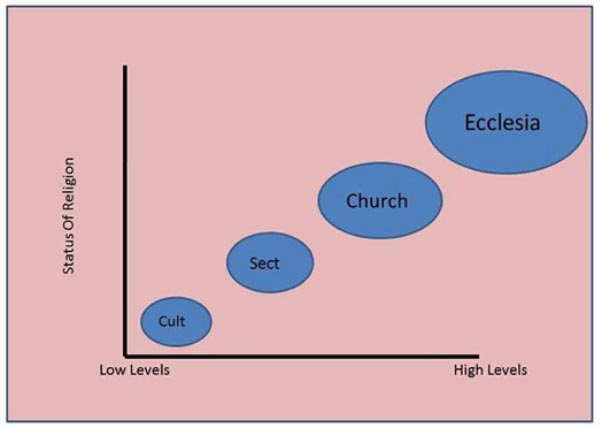
One final concept should be discussed. Secularization is the trend toward worldly concerns and away from concerns for the religiously sacred in the lives of society's members. The recent history of increasing levels of being “disaffiliated or unaffiliated” reported above coincide directly with the increase in secularization. The COVID 19 pandemic that caused so many larger social and personal disruptions of people in the United States (and world). As a Sociologists I was amazed that the “science versus religion” levels of contention that became so openly contested by media, by politicians, and between individuals. Scientists trust science even if not everything is yet known and it has to use trial and error research to solve problems. Religious and conservative people watched science flounder and found it very confusing and contradictory how “scientific-based” intervention strategies failed to slow the pandemic, failed to preserve lives, and led to even more extreme polarization of conservatives and liberals. The one truth both sides appear to agree on is that science is not perfect, but scientists will likely find a vaccine for COVID 19 as they have in past epidemic and pandemic crises.
Additional Reading
Search Internet for:
- faith
- liberation theology
- Ernst Troeltsch
- state church
- denomination
- cult
- religious affiliation
- civil religion
- fundamentalism
- rituals
- cosmology
- religious experience
- born again
- spirit of capitalism
- protestant ethic
- charismatic leader
- theism
- Karl
- Marx
- alienation
- secular thinking
- religious economy
- new religious movement
- religious movements
- world-affirming movements
- new age movements
- world-rejecting movements
- total institutions
- world-accommodating movements
- religious nationalism
- disestablishment
- evangelicalism fundamentalists
- liberation theology
- fundamentalism
- religious experience
- established sect
- Sacred
- Profane
- Liminal period
- Secularization
- Sect
- Cult
- Monotheistic
- Extrinsic religiosity
- Intrinsic Religiosity
- Unchurched
- Secular
If you find the scientific study of religion to be interesting you might consider some of the Webpages below:
- The Association of Religion Data Archives at LINK
- SSSR Society for the Scientific Study of Religion at LINK
- ASR Association for the Sociology of Religion at LINK
- Greek Orthodox Archdiocese of America at LINK
- The Website of The Baha’is Faith LINK
If you find the scientific study of religion to be interesting you might consider some of the Webpages below:
- The Association of Religion Data Archives at LINK
- SSSR Society for the Scientific Study of Religion at LINK
- ASR Association for the Sociology of Religion at LINK
- Greek Orthodox Archdiocese of America at LINK
- The Website of The Baha’is Faith LINK
- American Atheists at LINK
- Rastafarian.net at LINK
- Association of Statisticians of American Religious Bodies at LINK
- The Yearbook of American and Canadian Churches at LINK
- The National Council of Churches at LINK
- Beliefnet.com LINK
- American Buddhist at LINK
- American and World Sikhs at LINK
- American Hindu net at LINK
- American Jewish History at LINK or LINK
- Black American Jews at LINK
- The Anglican Communion at LINK
- The Southern Poverty Law Center teaching Tolerance at LINK
- The American Muslim at LINK
- Muslim American Society at LINK
- The American Catholic Church in the United States at LINK
- The Church of Jesus Christ of Latter-day Saints (Mormons) at LINK
- The Southern Baptist Convention at LINK
- The American Association of Lutheran Churches at LINK
- The African Methodist Episcopal Zion Church at LINK
- National Baptist Convention of America Inc. at LINK
- Pew Religious Project LINK
- Gallup research on religious topics LINK